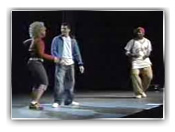Science Tuesday: The Hip-Hoppers
 I guess that schools have to do whatever it takes in order to hook kids into science. But I never would have thought that the hook would involve hip hop music:
I guess that schools have to do whatever it takes in order to hook kids into science. But I never would have thought that the hook would involve hip hop music: Largo, Florida - NASA believes the first person to walk on Mars may be sitting in an elementary or middle school somewhere in the country. It sounds exciting, except not many kids are choosing careers in science.Like I said. They're doing whatever it takes.
Honeywell reports the number of science and math related fields is growing at three times the rate than any other profession. So to inspire kids to pursue science careers, NASA and Honeywell have developed an award winning program that holds students’ attention.
Using hip hop music and break dancing moves, science class never looked like this.
Eric Olson, Performer for “FMA Live”:
"By the end of this show, you'll know the three laws of motion inside and out"
Three actors take Largo Middle School students through a science lesson they may never forget.
Students learn about inertia using a large Velcro wall. Kylie Fox demonstrates force equals mass multiplied by acceleration.
Olson:
“Kylie got a strong leg look at how big this soccer ball is the reason she didn't budge is it's massive mass."
Kylie Fox, 8th Grader, Largo Middle School:
“It was kind of confusing learning out of the book but doing this is a lot easier doing hands on activities learning it with the soccer ball it helped."
Teachers get into the act too as Suma wrestlers to teach the lesson on force. The science concert is Honeywell International and NASA's way of showing students science is cool.
Candi Hall, Performer “FMA Live”:
“To try and bring it to life to really inspire them about math, enjoy math, enjoy science, technology see it can be fun."
Gurart Radani, 8th Grader Largo Middle School:
“Here they made the stuff you learn in class really stick with you."
A 45 minute concert may just spark some future Sir Isaac Newton in these students.
Radani:
"You see the great scientist and what they have done our generation has to take over have to come up with something as great or even better."
The three year long program has been traveling the country since 2004. So far, they’ve visited 73,000 students at 153 schools in 32 states.
I wonder if this is the way secondary schools teach science in Japan or Germany?









<< Home